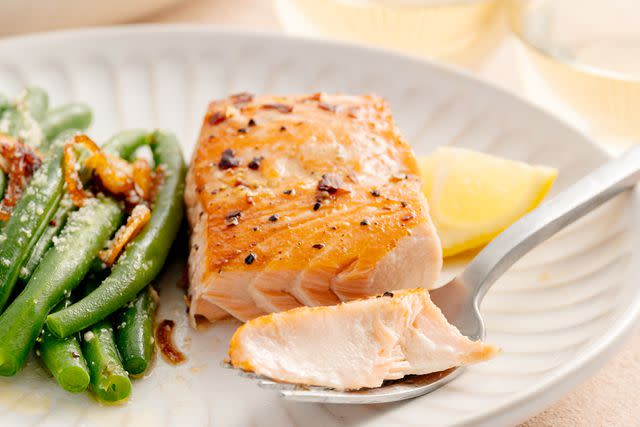Salmon Temperature: When Is Salmon Done?
For best results, use a thermometer, but there are other methods, too.

Simply Recipes / Ciara Kehoe
Some like it raw, some like it cooked through. Since there are so many ways to enjoy salmon, how do you know when it’s fully cooked to your liking? The two factors to consider when figuring out how to tell when salmon is done are the thickness of the fish and your own preference. Do you like it warm, firm, and flaky, or silky with a cooler strip of ruby flesh in the middle?
Best Temperature
Cooking salmon above 145°F makes it tough and dry. If you like your salmon fully cooked, 145°F is a good temperature to reach.
What’s The Temperature of Cooked Salmon?
Use the guidelines below, depending on how you like your salmon cooked.
Fully Cooked Through: According to the United States Department of Agriculture, the thickest part of a salmon filet or side should reach an internal temperature of 145°F. If you follow these guidelines, your fish will be fully cooked though, with no raw or silky interior. And, if you’re serving to a large crowd whose dietary comfort zones may vary, probably preferable. Just don’t go above this temperature, otherwise, your salmon will become tough, dry, and more like the dreaded airplane food version of this beloved swimmer than the restaurant-quality salmon you can cook in the comfort of your own kitchen.
Medium-Rare (Farmed): If you prefer medium-rare salmon and you’re preparing farmed filets (which all Atlantic salmon sold in America is), cook until the middle is 125 to 135°F.
Medium Rare (Wild): If you’re cooking wild salmon, medium-rare is between 120 to 130°F. Why the difference? Wild salmon has more connective tissue because it moves around a lot more—miles and miles more— than farmed salmon. This extra connective tissue means that muscle fibers can end up dry or tough if overcooked. Also, some varieties of wild salmon are leaner than the farmed kind, which means less fat to contribute to a juicer final product. Our advice? Cook wild salmon five degrees lower than how you like your farmed salmon.
Read More: What’s the Difference Between Atlantic and Pacific Salmon?

Simply Recipes / Ciara Kehoe
How To Check Salmon’s Temperature: Three Ways
Instant-read thermometer: Stick the thermometer into the middle of the filet to test the temperature. Go at least as deep as the dimple in the metal probe of the thermometer. If it won't go deep enough from the top, insert it in the side. Leave it in at least 10 seconds for an accurate reading.
Metal cake tester: If you don’t have a thermometer, you can prick a cake tester or fork tine into the fish. If the tester comes out cold, the fish is still rare. If it’s warm but tolerable to the touch, it’s medium rare, and if it’s hot, take that fish off the heat because it’s done!
Fork: Alternatively, you can test the fish with a fork to see how easily it flakes. Flaky fish is cooked. The more resistance there is, the rarer it is.
Don’t Fear Undercooking Salmon
Remember that like with all food, the salmon will continue cooking a little after you remove it from the heat source, meaning the internal temperature may continue to climb a few degrees. So take that into consideration and remove the fish from the heat when it’s a few degrees below your target. (It’s the same when you’re cooking a steak if that’s more familiar.)
You can always stick the fish back on the grill or in the oven for a few seconds if you need. But you can’t reverse matters once the salmon is overcooked. And it’s too splendid a fish to ruin.

Simply Recipes / Nick Evans
Our Favorite Salmon Recipes
Read the original article on Simply Recipes.
